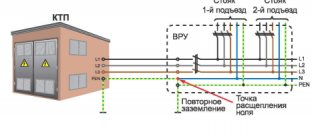A floor plan is a schematic representation of a building, including plans for residential (non-residential), utility rooms, the location of stairs, platforms, elevators, garbage chutes, loggias, galleries, fire escapes, emergency exits, etc. Often, owners, as well as those who are just planning to buy a home, want to find a floor plan of a house at an address on the Internet, without leaving home, and preferably for free. As much as possible?
Why might you need a floor plan?
The need for a floor plan may arise when carrying out transactions with real estate, its privatization, changing the type and purpose of the premises (in particular, when transferring premises from the category “residential” to “non-residential” and vice versa), redevelopment of an apartment and in other cases.
Information contained in a floor plan
The floor plan contains the following information:
- about the series of the building and the year of construction;
- about the material of load-bearing walls and ceilings;
- ceiling height;
- number of floors;
- number of one-, two-, three-, four-room apartments;
- living space and apartment layout;
- the presence of balconies and loggias;
- degree of wear and tear of the building;
- the presence of re-equipment or major repairs;
- whether the building is an architectural object or cultural heritage.
Additional information includes:
- about the type of premises (are there any premises of the “dormitory” or “hotel” type, apartment or corridor type);
- apartment numbering;
- Is the house located within the Garden Ring?
Such information can be obtained today on the Internet, but since it is provided by the BTI, it is mainly paid.
Where can I get a floor plan of a house by address?
You can get it in the standard way - using an extract from the Unified State Register of Real Estate, ordering this service separately. Information about all real estate objects is stored in the state cadastre. All technical documentation (cadastral, floor, situational plans, explications) are prepared at the BTI by specialist engineers.
Currently, the state cadastre and MBTI are combined into a single state real estate register - EGRN.
To obtain a PPD, an application is written, a passport and a title document for the apartment are provided.
Labeling principles
A set of Roman and Arabic numerals denoting a series was seen by everyone who looked at advertisements for the sale or rental of apartments. To understand what this sequence means, you need to know what role each character in the set plays.
Roman numerals are used to indicate the design features of a category of houses. So, I implies longitudinal load-bearing walls. II - transverse load-bearing, plus longitudinal stiffening diaphragms. III - longitudinal load-bearing and transverse diaphragms.
With Arabic numerals it is already more difficult - in the 70-90s of the last century, two, sometimes three groups of numbers were used to designate one or another series of buildings. The first indicated the type of structure, the number of sections and the material used for construction. So, for example, the numbers 114 mean a multi-section multi-apartment residential building made of brick. Group 121 meant that we are talking about a single-section multi-apartment panel tower, 124 symbolizes a single-section multi-apartment brick tower. The series of buildings was indicated by the second group of numbers.
Sometimes a third was added: at the very end, after the period. This is the year of construction.
How to find out the layout of an apartment by address on the Internet
You can get approximate and brief information on the Internet:
- about the building series;
- number of floors;
- wall material;
- approximate year of construction.
Definition of house series
One free resource is tipdoma.com. The sequence of actions is as follows:
- Open Yandex.maps https://yandex.ru/maps.
- Enter the address of the house in the search field.
- Based on the photograph of the house, we determine the number of floors, wall material and the approximate year of construction.
In this case, you need to have basic knowledge of what houses were built in different years:
- 30 - 50s of the last century - cinder block “Stalin”;
- late 50s - early 80s - “Khrushchev” buildings (block, brick and panel);
- in the 60s the first brick 9- and 12-story buildings appeared;
- in the 70s - multi-sectional panel, brick and block buildings;
- 80s - standard new buildings: 9-story panel houses;
- in the 90s, standard ones were built and new series of multi-story panel buildings from 17 to 25 floors appeared;
- 2000s - panel, block, panel-block, monolithic houses.
(Detailed information about the building years and series can be found on Wikipedia on this page).
We enter the obtained characteristics into the search form field at tipdoma.com.
Photos of houses will open, and from them you need to select the building that is most similar to the one found in Yandex.maps. Below the photo is the series of the house.
Based on the series of the house, you can also find out the PPD and the apartment plan, but for this you need to contact:
- to the city construction (architectural) department;
- construction organizations;
- design institutes.
You can also try to find PPD for a building series, using various resources on this topic, forums and social networks. Apartment layouts along with floor plans in new housing complexes in megacities are usually available on the Internet.
What to do if the building series is unknown
In some cases, the project series cannot be found. This happens during construction:
- houses according to an individual project;
- new buildings that have not yet been put into operation.
When purchasing housing in a house under construction, information about the series of the building design and the floor plan of the house can be obtained free of charge from the developer with whom the contract has been concluded.
Floor plan of a house at an address in Moscow
For residents of Moscow and St. Petersburg, the task of obtaining a floor plan of a house by address is simplified. In capital cities you can find complete information about houses on the website nesprosta.ru. The information here will not be provided for free, but it will be comprehensive.
Another plus is that:
- information comes directly from the BTI;
- no need to look for construction companies and organizations;
- leave the house and waste your time.
To get a floor plan with an explanation, indicating the number of floors, room size and other information, you must enter the street name and house number in the search field.
Block and “brezhnevka”
During the years of the USSR, standard block houses and so-called Brezhnevkas were actively built. Each type of storey residential buildings has its own characteristic distinctive features, thanks to which you can independently determine their identity:
Common serial numbers for such residential properties are P-42, I-209, and 1605AM. Dear readers!
Our articles talk about typical ways to resolve legal issues, but each case is unique. If you want to find out how to solve your specific problem, please contact the online consultant form on the right →
It's fast and free!
Or call us by phone (24/7):
If you want to find out how to solve your particular problem, call us by phone. It's fast and free!
+7 Moscow,
Moscow region +7 (812) 426-14-65
St. Petersburg,
Leningrad region +7 (800) 500-27-29 ext.
529 Regions (free call for all regions of Russia)
Find out the year the house was built by address offline
You can find out the necessary information without resorting to the help of the World Wide Web. To do this, you will need some documents and, in most cases, the rights of the owner.
View the cadastral document
The easiest way is to look at the cadastral passport, if such paper is available. The year the house was built will be indicated there. In addition to this information, the document indicates: how many floors there are in the construction, what the walls are made of, the purpose of this building, its cadastral figures. If you do not have a cadastral passport, you should obtain one. To do this, just contact the BTI or Rosreestr.
In order to find out when the house was built by address, you should provide the correct address of the high-rise building in the BTI and the cadastral number. To obtain the necessary information you will need some documents:
- ID card (passport);
- confirmation of the owner’s rights in the form of an extract from the Unified State Register of Real Estate;
- check indicating payment of state duty in the amount of 200 rubles.
The cadastral document in question can be provided to those who are the owners, which means that for those who simply want to find out information before purchasing real estate, this option is not suitable.
Extract from the technical passport of the BTI
Information about the house at the address is contained in an extract from the technical passport of the BTI in form 1B. To obtain this document, you must personally contact the BTI. You must have an identification card with you, as well as a title document.
Providing such information is a paid service and takes more than one day to process. In the capital, you can obtain an extract from a technical passport for 1,100 rubles and within 10 days. If information is needed by a citizen who works for a legal entity, he should have with him a power of attorney from the general director and a special guarantee document.
Operational document
The operational passport stores all the most important information about the capital structure. The document is not given in person, but information from it can be provided. You can request this document directly from the operating organization. To do this, you should draw up an application in which you indicate the full name and address to which the response with information should be sent, the name of the organization itself, where the application is sent, what information the applicant wants to know, and at the end - the date and signature.
The response should arrive within 30 days. This may be either necessary information or a refusal to provide it, indicating valid reasons. They simply have no right to refuse. If the reason can be eliminated, then there is a chance to try to submit the application a second time, taking into account the refusal.
Certificate of putting the object into operation
The year the house was put into operation is also the year it was built. This information is indicated in the act of putting the building into operation. Places where such a document can be stored: state archive, with the developer, local branch of the BTI, design company. Action algorithm:
- call all of the above organizations and find out exactly where the required act is located;
- ask about the necessary algorithm of action to obtain information;
- write a statement asking for information.
Usually this is not difficult and the answer can be obtained quickly.
Help from the archive
You can also find a series of houses at the address in the state archives. This method is for those who have time to look for documents themselves or wait until employees find the necessary information.
Contacting the administration
All necessary and important information about houses and other capital objects is also stored in the local administration. But you need to apply only if other methods have not brought the desired results.
Individual and brick-monolithic
The individual type of home is widespread nowadays. It is worth noting separately, since the series is assigned even to a brick house that was built by the owner according to a standard design. There are no restrictions set for him, so boundless imagination is often used. Of course, in this case, the owner is interested in thermal and sound insulation, comfort, external design, high-quality repairs and double-glazed windows. Such buildings are distinguished by their high cost, which consists of the location of the house, the environmental situation, infrastructure and other things.
Speaking about brick-monolithic houses, their popularity is about the same as that of classic brick buildings. The structure of such buildings is distinguished by a monolithic concrete frame, which will later be finished with brick. Thus, the value of the property decreases without loss of strength and reliability. The structure can withstand disasters such as floods and even earthquakes. Inside, all partitions play the role of load-bearing walls, and the building will not require significant repairs for a hundred years.
Date of construction of the house at the address on Internet sites
For those who are fluent in computers, there are several methods to find out in what year a house was built at an address on the Internet. The convenience of these methods is that on many sites it is not necessary to order a document; if necessary, you can simply view the necessary information.
Rosreestr website
The Rosreestr website contains a huge amount of necessary and important information on all permanent buildings. Separately, there is a service where you can order an extract from the cadastral document for a building or this document itself.
All documents sent from this site will be in electronic form. The service is paid, the cost is 150 rubles. This is the standard cost of such a state duty. Order fulfillment time is 5 working days. Instead of the document itself, they can form a link to it.
BTI website
The Technical Inventory Bureau also has its own website, where you can get information of interest on the year the building was built. This service is not available in all cities, but most often only in large ones. The algorithm of actions is the same: fill out an online application and pay the state fee. The specific amount of the state duty depends on the region. Deadlines also differ everywhere, but they are indicated on the local website. The document is sent electronically.
Website "Home. Ministry of Housing and Public Utilities"
This site is a community project. Here you can find out the age of the house by address, its series, number, date of construction, commissioning, cadastral number, as well as area, number of floors and other important information.
The details of the management company of each house are also listed here, including its contact details. The object database contains data on houses in 80 regions of the country. The catalog is regularly updated with new information and expanded. By the way, anyone can send information about their home there if it is not in the database. The information will be checked and added.
Capital series
There are separate rules for designating Moscow buildings: a group of characters, then a slash (slash) and the next number. The numbers before the slash indicate the number, after that the number of floors. Example: 1-515/5 (“Khrushchev” of five floors); 1605/9 (standard nine-story building).
Some modifications of standard categories were separated by engineers into separate families, since in all respects they differed significantly from the original. A striking example is the P-3M series (panel towers, which can have from nine to seventeen floors) and the modification P-3M-7/23 (twenty-three-story building) that “spun off” from it.
For a number of series of metropolitan buildings, both Arabic and Roman numerals are used. Usually these are three groups of characters separated by a hyphen: first a Roman numeral, then two and two more Arabic ones: II-49-04. The latter indicate the number of sections. So, if at the end of the set there are numbers 01 and 02, respectively, we are talking about a one- and two-entry tower.
Where can I find design documentation for an apartment building?
Content:
The construction of an apartment building (MCD) is a complex process that is impossible without the preparation of appropriate design documentation. However, this does not mean at all that after completion of construction you can forget about the project: design (and technical) documentation is absolutely necessary in the process of further operation of the apartment building. In addition, many apartment owners are faced with poor quality construction and maintenance work.
If you have a dispute with a developer or management company (MC), with a high degree of probability you cannot do without obtaining project documentation (it will allow you to prove deviations from the project, errors, etc.). And even if you manage to find a project for the house (you will learn about where the documentation should be stored from our material), without professional legal support in a dispute with the management company or developer, it will be difficult to achieve success. A lawyer will assess your chances of winning in court, prepare all the necessary documents and ensure that your interests are represented.
All-Union serial buildings of the early period
According to standards, until about the 70s of the last century, five floors were considered optimal for a residential building. Sometimes six-story buildings were built so that shops and other service enterprises would be located below.
All-Union ones include:
- so-called Stalinist buildings (II-01; II-08);
- 1-440;
- 1-449;
- K-6;
- brick 1-511 and 1-447;
- block five-story buildings (1-502; 1-504; 1-507; 1-510; 1-511);
- five-story panel buildings K-7;
- five-story panel buildings (1-318; 1-335, in particular, subseries 1-335a and 1-335d; 1-464).
Residential buildings during the reign of N.S. Khrushchev are distinguished by low ceilings, walk-through rooms, and combined bathrooms. They are also characterized by low noise and heat insulation and other shortcomings, which citizens often corrected on their own. They have been recognized as subject to demolition since the late 1980s of the last century, but in most Russian cities they have survived and are still inhabited.
Who is responsible for storing documentation for the house?
So, during the life of an apartment building, a huge number of situations arise in which it may be necessary to refer to design documentation. This category of documents is part of the technical documentation, which, in turn, should be available to every MKD. According to existing rules, the technical documentation of a house includes:
- MKD technical passport;
- town planning and cadastral plans for the site on which the apartment building is located;
- design documentation;
- inspection reports;
- extract from Rosreestr;
- documents for installed metering devices and some other papers.
It is necessary to note that the owners of the apartment building documentation are in possession of them, but in the case of an apartment building, each apartment owner cannot have such documents. Storage is handled by a management company, which is responsible for maintaining and storing technical documentation.
Important! Managing organizations may have at their disposal both originals and copies of technical documentation. The project of an apartment building can be transferred to the management company electronically.
Other massive developments
After the introduction of the Unified Catalog, a number of standard projects were developed:
- multi-section nine-story buildings 1-515/9sh; 1605/9;
- Shch-5416 (brick twelve-story building);
- 1605/12 - designed according to the five-story principle, but with twelve floors;
- II-29;
- BM-4 (mainly in small towns);
- block towers II-18/9 (nine-story) and II-68 (sixteen-story);
- II-57;
- II-66;
- "Ships" 1-LG-600;
- sixteen-story panel towers K7/16 and K8/16;
- 111-120;
- 111-108;
- 111-121;
- M111-90;
- M-464.
In the eighties, sixteen-story panel buildings of projects P-3 appeared; P-4; P-43 and P-44. In some cities of Russia there are also twenty-two-story options.
Is the developer obliged to store project documentation?
If you need to obtain project documentation, then the first step should be to contact the management company. However, there are often cases when management companies declare that they do not have a project (for example, when transferring an apartment building to management, the documents were not provided in full). In this case, you can contact the developer who was involved in the construction of the apartment building.
At the same time, not everything is clear with the storage of documentation by the developer. According to SNiP 3.01.04-87 (approved on April 21, 1987), even after the apartment building has been accepted into operation, the originals of the project and other technical documents must be kept by the developer. But in the same 1987, changes were made to SNiP, according to which technical documentation should be transferred to operating organizations. At the moment, the courts adhere to the following position: if the developer cannot prove that he transferred the apartment building project and technical documents to third parties (MC, investor, etc.), then he is recognized as responsible for their storage (according to the original version of SNiP) .
Important! Project documentation must be stored until it is entered into the archive: by law, this period is 20 years. After the documents receive archival status, their storage will be handled by the state or municipal archive.
Special cases of marking modern projects
In technical documentation and real estate catalogs, other combinations of letters to designate modern buildings are also common:
- KOPE (literally: catalog space-planning elements, a series of panel high-rise buildings from the Mosproject design institution);
- E - experimental project;
- K/M - brick-monolithic;
- MO - the houses belong to the Ministry of Defense of the Russian Federation.
To mark modern houses in the Moscow region, they use the Cyrillic alphabet for the manufacturer and Arabic numerals indicating the year of construction.
So, for example, under the letter “N” lies “Narostroy” (Naro-Fominsk Construction Organization), “S” is used to designate the Serpukhov House-Building Plant. Some modern Moscow houses are “coded” using the same principle. Thus, the presence of the GMS group indicates that the developer is Glavmosstroy.
What to do if documentation is lost?
The current rules provide for a certain procedure for transferring documents to an apartment building (for example, when changing the management company), which is designed to prevent the loss of papers. The following points are fundamental:
- when transferring the functions of managing an apartment building to a new management company, documents are provided within 30 days;
- the transferred package of documents must correspond to the full list, and if any paper is missing, it must be restored;
- Responsibility for checking the completeness and relevance of the documents provided rests with the company to which the functions of managing the house are transferred.
But despite the existence of such a procedure, documents for houses are still often lost. Owners of apartments in old buildings that were previously under municipal management are especially often faced with this situation. If documents for an apartment building have been lost, you must contact the local government with a corresponding application. Applications should also be sent to the housing inspectorate and the prosecutor's office. The restoration of documents in such situations should be carried out by the persons who were entrusted with the responsibility for their storage (and the restoration occurs at their own expense).
Monolithic and panel
Typical designs of monolithic storey residential buildings are distinguished by the fact that they consist entirely of concrete. Essentially, formwork is placed at the construction site, where concrete is then poured. It follows from this that there will be no seams on the walls, which means that the thermal and noise insulation in such housing is excellent. Moreover, additional insulating material is often used, and the walls are thinner than brick ones. However, that is no less durable. Despite rumors that rely on the harmful properties of monoliths due to the supposedly non-breathable walls of apartments, modern materials completely refute this myth. Fears are associated with old buildings from the times of the USSR, when not particularly high-quality materials were used, but this has long been gone.
The panel type is completely divided into several categories, divided by area. For example, panel houses of the 137 series are very spacious, but their maximum area is 70 square meters. (kitchen 9 sq. m.). This is followed by the six hundredth series of the middle class with apartments of no more than 65 square meters. (kitchen 7 sq. m.). The third option is budget houses 504 series with a kitchen of 6.3 sq. m. Their distinguishing features are also very high windows and the absence of a window sill.
Demolition of five-story buildings in Moscow in 2020
Of course, it was impossible to implement this large-scale project even in one decade, so the demolition of five-story buildings in Moscow was carried out in stages. Now dismantling is being carried out in accordance with the state program “Housing”, which initially included 1,722 houses of the “demolished” series built from 1955 to 1969.
As the head of the Moscow construction department Andrei Bochkarev said, in 2021 it is planned to demolish another 98 houses of this period in the following metropolitan districts: Northern, Eastern, Southwestern and Northwestern. All houses in the Central, South-Eastern, Southern and Zelenograd districts have already been safely dismantled.
The order of demolition of five-story buildings under the renovation program
Each apartment will have a modern turnkey renovation, light-colored wallpaper on the walls, laminate or linoleum on the floor. It is planned to install double-glazed windows, tiles on the balcony floor, interior doors, electrical wiring, and plumbing equipment. Residents will only have to supply furniture and appliances.
Apartment owners are concerned not only with the order of demolition of five-story buildings under the renovation program, but also with whether they will continue to live in the same area as before. According to the rules of the project, residents will be resettled in new buildings in a similar administrative district of the city.
26 Apr 2021 glavurist 339
Share this post
- Related Posts
- When will the pension for disabled children be recalculated?
- How many points are awarded per year for caring for 3 elderly people at once?
- What punishment is provided by law for illegal business?
- How much will the state fee cost for registering a mortgage in a bank?









